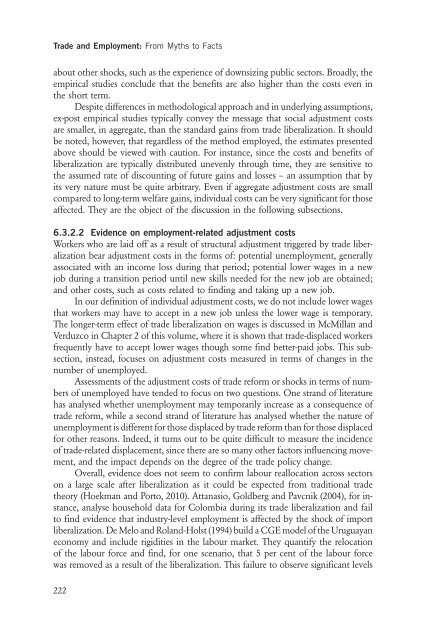Trade and Employment From Myths to Facts - International Labour ...
Trade and Employment From Myths to Facts - International Labour ...
Trade and Employment From Myths to Facts - International Labour ...
Create successful ePaper yourself
Turn your PDF publications into a flip-book with our unique Google optimized e-Paper software.
<strong>Trade</strong> <strong>and</strong> <strong>Employment</strong>: <strong>From</strong> <strong>Myths</strong> <strong>to</strong> <strong>Facts</strong><br />
about other shocks, such as the experience of downsizing public sec<strong>to</strong>rs. Broadly, the<br />
empirical studies conclude that the benefits are also higher than the costs even in<br />
the short term.<br />
Despite differences in methodological approach <strong>and</strong> in underlying assumptions,<br />
ex-post empirical studies typically convey the message that social adjustment costs<br />
are smaller, in aggregate, than the st<strong>and</strong>ard gains from trade liberalization. It should<br />
be noted, however, that regardless of the method employed, the estimates presented<br />
above should be viewed with caution. For instance, since the costs <strong>and</strong> benefits of<br />
liberalization are typically distributed unevenly through time, they are sensitive <strong>to</strong><br />
the assumed rate of discounting of future gains <strong>and</strong> losses – an assumption that by<br />
its very nature must be quite arbitrary. Even if aggregate adjustment costs are small<br />
compared <strong>to</strong> long-term welfare gains, individual costs can be very significant for those<br />
affected. They are the object of the discussion in the following subsections.<br />
6.3.2.2 Evidence on employment-related adjustment costs<br />
Workers who are laid off as a result of structural adjustment triggered by trade liberalization<br />
bear adjustment costs in the forms of: potential unemployment, generally<br />
associated with an income loss during that period; potential lower wages in a new<br />
job during a transition period until new skills needed for the new job are obtained;<br />
<strong>and</strong> other costs, such as costs related <strong>to</strong> finding <strong>and</strong> taking up a new job.<br />
In our definition of individual adjustment costs, we do not include lower wages<br />
that workers may have <strong>to</strong> accept in a new job unless the lower wage is temporary.<br />
The longer-term effect of trade liberalization on wages is discussed in McMillan <strong>and</strong><br />
Verduzco in Chapter 2 of this volume, where it is shown that trade-displaced workers<br />
frequently have <strong>to</strong> accept lower wages though some find better-paid jobs. This subsection,<br />
instead, focuses on adjustment costs measured in terms of changes in the<br />
number of unemployed.<br />
Assessments of the adjustment costs of trade reform or shocks in terms of numbers<br />
of unemployed have tended <strong>to</strong> focus on two questions. One str<strong>and</strong> of literature<br />
has analysed whether unemployment may temporarily increase as a consequence of<br />
trade reform, while a second str<strong>and</strong> of literature has analysed whether the nature of<br />
unemployment is different for those displaced by trade reform than for those displaced<br />
for other reasons. Indeed, it turns out <strong>to</strong> be quite difficult <strong>to</strong> measure the incidence<br />
of trade-related displacement, since there are so many other fac<strong>to</strong>rs influencing movement,<br />
<strong>and</strong> the impact depends on the degree of the trade policy change.<br />
Overall, evidence does not seem <strong>to</strong> confirm labour reallocation across sec<strong>to</strong>rs<br />
on a large scale after liberalization as it could be expected from traditional trade<br />
theory (Hoekman <strong>and</strong> Por<strong>to</strong>, 2010). Attanasio, Goldberg <strong>and</strong> Pavcnik (2004), for instance,<br />
analyse household data for Colombia during its trade liberalization <strong>and</strong> fail<br />
<strong>to</strong> find evidence that industry-level employment is affected by the shock of import<br />
liberalization. De Melo <strong>and</strong> Rol<strong>and</strong>-Holst (1994) build a CGE model of the Uruguayan<br />
economy <strong>and</strong> include rigidities in the labour market. They quantify the relocation<br />
of the labour force <strong>and</strong> find, for one scenario, that 5 per cent of the labour force<br />
was removed as a result of the liberalization. This failure <strong>to</strong> observe significant levels<br />
222

















